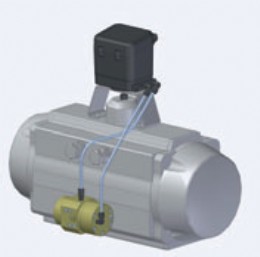Valves switch up to 4 times faster
Pneumatic volume booster for set point signal from positioner to actuator

Figure 1 The 4090 pneumatic volume booster minimises opening and closing times of pneumatically actuated control valves. The example shows a comparison of the opening times – without amplifier, with standard and “aggressive” amplification of the set point signal – for a single-acting actuator of ball sector valves of different nominal sizes.

Figure 2 The 4090 pneumatic volume booster for amplifying the supply air of the set point signal from positioner to actuator is connected directly to linear or part-turn actuators.
Pneumatic positioners match the particular current valve setting with the set point signal as a control value. The control air, as the input quantity, generally corresponds to a unit signal of 0.2 to 1 bar. Positioners are also volume boosters which convert the control air at a minimal pressure to a proportional, high control pressure for the positioning of the valve. However, control valves with large volume, pneumaticallyoperated, part-turn and piston actuators usually need several seconds for large positioning processes or to close or open fully. Concerning valves from DN 150 upwards or with actuator volumes > 14 dm2, this results in restrictions in control quality. Now, with the newly developed, high precision 4090 pneumatic volume booster from Schubert & Salzer Control Systems, it is possible to amplify the air strength of the set point signal from positioner to actuator such that these control valves – depending on nominal valve size – operate up to 4 times faster without any further modification. The pneumatic volume booster is based on a diaphragm system with which the pressure and volumetric flow of the control air are increased up to 6 bar through the controlled insertion of supply air. In the volume booster, the control air is fed through an adjustable bypass to the actuator. By controlling the flow rate in the bypass, the switching threshold for activating the amplifying air can be controlled precisely. This ensures that the pneumatic volume booster applies the default amount of supply air to the actuator with small changes in pressure, i.e. small control interventions. When the adjustable bypass pressure threshold is exceeded, the pneumatic volume booster is activated and releases the additional pressure amplification for the control air so that the adjustment of the valve stroke or, respectively, the part-turn actuator is substantially faster. In the venting also of the actuator, the pneumatic volume booster adopts the same function and makes a vent valve operate when the supply air pressure is reduced. An exhaust air filter fitted here minimises sound emission. The 4090 pneumatic volume booster enables significant reductions in switching times (Fig. 1) both in the closing as well as the opening of a valve. Using a DN 300 ball sector valve for a direct comparison, the closing time for a single-acting actuator falls from 43 seconds to 21.5 seconds with a standard setting and to just 10 seconds with an “aggressive” bypass setting on the booster. This new pneumatic volume booster not only shortens switching times significantly but also optimises the control quality particularly for control valves in the larger nominal sizes. The volume booster (Fig. 2) can also be connected retroactively with ease to G 1/4" in-line linear actuators and to part-turn actuators with a Namur (1/4" ) interface.
Schubert & Salzer Control Systems
www.schubert-salzer.com
Published: 20th March 2013












